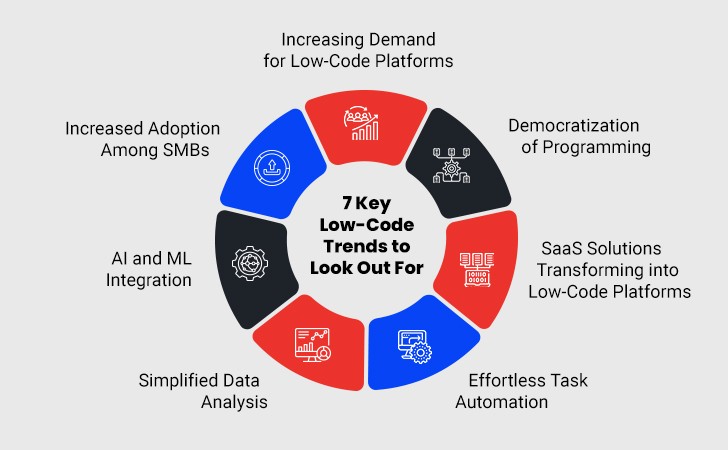To stay competitive in this fast-changing world, organizations constantly need to build innovative business models and optimize processes and workflows. Low-code solutions have emerged as a disruptive force that is helping businesses transform at speed and scale. No wonder companies are turning to low-code platforms to keep pace with the evolving requirements. In this detailed post, we’ll discuss how low-code trends are likely to affect the industry in the days to come.
7 Key Low-Code Trends to Look Out For
1. Increasing Demand for Low-Code Platforms
Going by the recent statistics, one can easily recognize the surge in demand for low-code technology. The global market size for low-code development is predicted to touch USD 264.40 billion by 2032, as per a recent study by Fortune Business InsightsFortune Business Insights.
The reason behind low-code’s rapid growth is simple. Low-code platforms empower organizations to develop and deploy custom business solutions quickly and cost-efficiently. Low-code provides businesses with the capability to devise technology-driven products without exhausting their budgets.
Instead of writing thousands of lines of code, citizen developers use visual drag-and-drop elements to create robust applications in months. Compare this to conventional application development, which may take up to a year or even more. Besides, it allows business experts to partake in solution delivery.
Elevating Customer Experience with Low-Code
2. Democratization of Programming
The last decade witnessed the rise of ‘citizen developers’ or business users with little to no coding experience who are building or enhancing business applications without the involvement of IT experts. For instance, nowadays, an e-commerce player makes changes to their portal without relying on their IT staff. This way, businesses slash the total cost of ownership as well.
As a low-code platform enables teams to build workflows and processes quickly using existing code components, it frees programming experts to focus on complex projects. No wonder the low-code market is catching up fast. According to a recent study, 70% of new applications developed by companies will use low-code technologies by 2025.
3. SaaS Solutions Transforming into Low-Code Platforms
A few years back, if business teams using Slack wanted to streamline workflows, they could only use the applications available in the App Directory. If they needed anything beyond what was already there, they couldn’t have it right away. Of course, they could develop a solution if they had coding experience or approach their IT teams or an external vendor to do the same; however, this would incur additional expenses.
Several long-established SaaS platforms including Slack, Salesforce, and Teams are incorporating low-code capabilities to enable users to build applications they need to boost performance.
Slack has created Workflow Builder that allows users to develop custom workflows and applications, without requiring them to know how to code. Likewise, Salesforce has come up with low-code tools for its Lightning platform that enabled Salesforce users to improve ROI.
As we move ahead, we’ll see more SaaS platforms embracing a low-code approach, or they may be surpassed by the competition.
Why You Should Consider Low-Code App Development
4. Effortless Task Automation
Another noteworthy trend to look out for is the increased role of low-code in task automation. The rising prevalence of low-code in the industry is paving the way for automation that helps tackle mundane, repetitive tasks that consume time and resources. Tasks such as reimbursement tracking and timecard punching fall into this category.
Automation is especially beneficial for organizations that are reeling under the pressure of finding qualified employees. While task automation won’t replace the workforce entirely, it helps the existing employees work much more efficiently and focus on critical aspects of their job.
For instance, customer service agents count on low-code to automatically send follow-ups to customers, which means they spend more time improving customer experience. Also, automation allows people from less specialized backgrounds to apply for certain positions.
5. Simplified Data Analysis
Data analysis is fundamental to the success of an organization. Though most businesses strive to be data-driven, getting there is no mean feat. This is primarily because organizations generate large volumes of unstructured data. As per recent stats, around 80-90% of data in any organization is unstructured. It is primarily in the form of text, video, social media data, and application logs, making it difficult for teams to utilize them for analysis. This further adds to the complexity of creating an AI/ML model. Building advanced AI/ML models involves various time-consuming tasks, including data collection, data cleansing, model training, and more.
Low-Code eases data collection, preparation, training, testing, analysis, and more. Low-code platforms integrate with APIs to aggregate data from different sources; this enhances the quality of AI/ML algorithms.
Low-Code-driven automation is used to cleanse data to make it suitable for training models. Data scientists use low-code libraries to train and deploy their solutions. Low-code platforms also provide modules to help users generate advanced visualizations of their data. In short, low-code platforms offer drag-and-drop capabilities that simplify tedious processes for data engineers and democratize AI for business users.
6. AI and ML Integration
Another low-code trend shaping the digital landscape is the integration of AI and ML in application development. With low-code platforms, teams benefit from AI-powered features that help automate tasks like app testing or code generation. This makes the app development process faster and easier. Moreover, these platforms are designed for people who might not have technical skills. This opens limitless opportunities for users to create useful applications that automate processes, recognize patterns, and make predictions. For instance, an ecommerce merchant uses low-code technology to make an app that predicts customer behavior based on past purchases. This helps the merchant offer personalized recommendations and makes customers happy.
7. Increased Adoption Among SMBs
Many large companies have started realizing the benefits of low-code development. This is the reason why SMBs are using the low-code platform extensively. It allows teams to build applications without requiring a lot of programming skills. This reduces the workload on IT departments. Additionally, many low-code platforms have improved their features over time. They now offer tools that support complex applications and provide better security options. This makes them appealing to organizations that need reliable and secure solutions. As more companies realize these benefits, the use of low-code platforms will keep growing in years to come.
The Final Word
There’s no denying that companies are capitalizing on low-code technology to realize superior business outcomes and gain a competitive advantage. Organizations are building high-performing solutions, such as online learning platforms, and e-commerce marketplaces using low-code drag-and-drop capabilities. As low-code continues to transform the digital space, businesses need to be aware of its limitations. Adhering to low-code best practices and understanding their pros and cons goes a long way in helping organizations implement their vision effectively.
Success Story: How Damco Helped a Fintech Company Transform Talent Acquisition with Low-Code
A Princeton-based FinTech company was looking for an integrated talent management solution to manage end-to-end talent acquisition and eliminate information silos. Damco utilized low-code technology to help the client build a custom Power Platform solution that streamlined talent management and brought all hiring-related information to one centralized repository.
Read more about this success story here.






